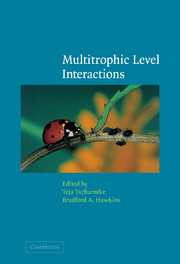Book contents
- Frontmatter
- Contents
- List of contributors
- 1 Multitrophic level interactions: an introduction
- 2 Plant genetic variation in tritrophic interactions
- 3 Multitrophic/multispecies mutualistic interactions: the role of non-mutualists in shaping and mediating mutualisms
- 4 Tritrophic interactions in tropical versus temperate communities
- 5 Endophytic fungi and interactions among host plants, herbivores, and natural enemies
- 6 Multitrophic interactions in space: metacommunity dynamics in fragmented landscapes
- 7 The chemical ecology of plant–caterpillar–parasitoid interactions
- 8 Canopy architecture and multitrophic interactions
- 9 Tritrophic below- and above-ground interactions in succession
- 10 Multitrophic interactions in decomposer food-webs
- Index
7 - The chemical ecology of plant–caterpillar–parasitoid interactions
Published online by Cambridge University Press: 08 August 2009
- Frontmatter
- Contents
- List of contributors
- 1 Multitrophic level interactions: an introduction
- 2 Plant genetic variation in tritrophic interactions
- 3 Multitrophic/multispecies mutualistic interactions: the role of non-mutualists in shaping and mediating mutualisms
- 4 Tritrophic interactions in tropical versus temperate communities
- 5 Endophytic fungi and interactions among host plants, herbivores, and natural enemies
- 6 Multitrophic interactions in space: metacommunity dynamics in fragmented landscapes
- 7 The chemical ecology of plant–caterpillar–parasitoid interactions
- 8 Canopy architecture and multitrophic interactions
- 9 Tritrophic below- and above-ground interactions in succession
- 10 Multitrophic interactions in decomposer food-webs
- Index
Summary
Introduction
Predators and parasitoids can be major mortality factors for many herbivorous insects. As such, these members of the third trophic level may positively affect the fitness of certain plants on which the herbivores feed. Such indirect ecological links between the third and first trophic level appear to have resulted in some spectacular adaptations in plants, as well as in the natural enemies. Most evident are the morphological adaptations that result in a very close relationship between certain plants (e.g., Cecropia and Acacia) and ants that use these plants as their home and major source of food. These plants may carry structures that allow them to harbor (in hollow thorns or roots) and feed (with extrafloral nectar organs or food bodies) ants. While the ants benefit from lodging and food, the plants benefit from protection against herbivores. It is generally accepted that the plant structures and secretions secure the protection by ants (e.g., Janzen, 1966; McKey, 1988; Oliveira, 1997).
A less obvious plant adaptation are the signals that plants emit when they are damaged by herbivores. These signals, which are emitted in the form of volatile substances, are used by predators and parasitoids to locate potential prey or hosts. Although there are several alternative possible functions for these emissions, evidence for their role in the attraction of the third trophic level is accumulating. This chapter selectively reviews and discusses this evidence.
- Type
- Chapter
- Information
- Multitrophic Level Interactions , pp. 148 - 173Publisher: Cambridge University PressPrint publication year: 2002
- 33
- Cited by



